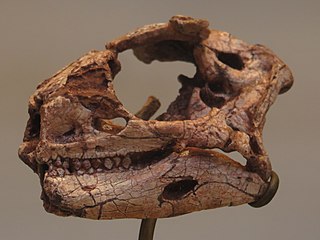
Lesothosaurus is a monospecific genus of ornithischian dinosaur that lived during the Early Jurassic in what is now South Africa and Lesotho. It was named by paleontologist Peter Galton in 1978, the name meaning "lizard from Lesotho". The genus has only one valid species, Lesothosaurus diagnosticus. Lesothosaurus is one of the most completely-known early ornithischians, based on numerous skull and postcranial fossils from the Upper Elliot Formation. It had a simpler tooth and jaw anatomy than later ornithischians, and may have been omnivorous in some parts of the year.

Abrictosaurus is a genus of heterodontosaurid dinosaur that lived during the Early Jurassic in what is now in parts of southern Africa such as Lesotho and South Africa. It was a bipedal herbivore or omnivore and was one of the most basal heterodontosaurids. It was approximately 1.2 metres (3.9 ft) long and weighed between 0.68 and 3 kilograms.
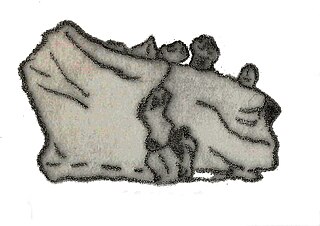
Fabrosaurus is an dubious extinct genus of ornithischian dinosaur that lived during the Early Jurassic during the Hettangian to Sinemurian stages 199 - 189 mya. It was originally placed within the now obsolete family Fabrosauridae.

Heterodontosaurus is a genus of heterodontosaurid dinosaur that lived during the Early Jurassic, 200–190 million years ago. Its only known member species, Heterodontosaurus tucki, was named in 1962 based on a skull discovered in South Africa. The genus name means "different toothed lizard", in reference to its unusual, heterodont dentition; the specific name honours G. C. Tuck, who supported the discoverers. Further specimens have since been found, including an almost complete skeleton in 1966.
Trimucrodon is a genus of ornithischian dinosaur from the Late Jurassic Lourinhã Formation of Portugal. The type, and currently only, species is T. cuneatus.

Revueltosaurus is an extinct genus of suchian pseudosuchian from Late Triassic deposits of New Mexico, Arizona and North Carolina, United States. Many specimens, mostly teeth, have been assigned to Revueltosaurus over the years. Currently, three species are included in this genus, all of which were originally thought to represent monospecific genera of basal ornithischian dinosaurs. It was 1 meter long.

Fulgurotherium is a dubious genus of ornithischian dinosaur from the Late Cretaceous (Cenomanian) Griman Creek Formation. It lived in what is now Australia.

Crosbysaurus is a genus of extinct archosauromorph that lived in the Late Triassic of Arizona, New Mexico, North Carolina, Texas, and Utah. It is known from the Chinle Formation and Dockum Group rock units from the southwestern United States. The type species is C. harrisae, and the only known material includes teeth. 11 specimens are known, each including a single tooth.
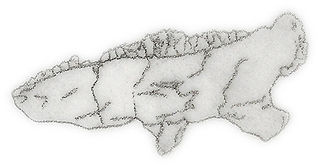
Tatisaurus is a genus of ornithischian dinosaur from the Early Jurassic from the Lower Lufeng Formation in Yunnan Province in China. Little is known as the remains are fragmentary. The type species is T. oehleri.
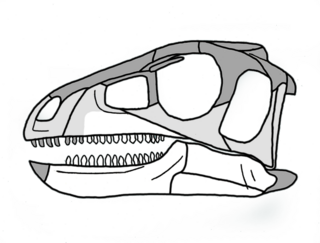
Pisanosaurus is an extinct genus of early dinosauriform, likely an ornithischian or silesaurid, from the Late Triassic of Argentina. It was a small, lightly built, ground-dwelling herbivore, that could grow up to an estimated 1 m (3.3 ft) long. Only one species, the type, Pisanosaurus mertii, is known, based on a single partial skeleton discovered in the Ischigualasto Formation of the Ischigualasto-Villa Unión Basin in northwestern Argentina. This part of the formation has been dated to the late Carnian, approximately 229 million years ago.
Protecovasaurus is a genus of archosaurian reptile from the Late Triassic of the southwestern United States. It was initially described as a basal ornithischian dinosaur, but was redescribed as a non-dinosaurian archosaur by Irmis et al. (2006). The type species, Protecovasaurus lucasi, was formally described by Andrew B. Heckert in 2004.

Eocursor is genus of basal ornithischian dinosaur that lived in what is now South Africa during the Early Jurassic. Remains of this animal have been found in the Upper Elliot Formation and it is among the most completely known early ornithischians, shedding new light on the origin of the group.
Phyllodontosuchus is a genus of sphenosuchian, a type of basal crocodylomorph, the clade that comprises the crocodilians and their closest kin. It is known from a skull and jaws from Lower Jurassic rocks of Yunnan, China. Phyllodontosuchus is unusual because some of its teeth were leaf-shaped, like those of some herbivorous dinosaurs, and it does not appear to have been a strict carnivore like most other crocodylomorphs.
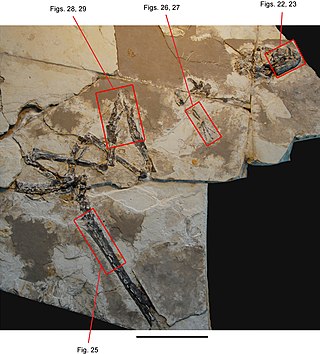
Tianyulong is an extinct genus of heterodontosaurid ornithischian dinosaur. The only species is T. confuciusi, whose remains were discovered in Jianchang County, Western Liaoning Province, China.
Sauropus is a dinosaur imprint. One imprint given this name may be from a sitting dinosaur, perhaps made by a dinosaur similar to Psittacosaurus. The authors of The Beginning of the Age of Dinosaurs: Faunal Change across the Triassic-Jurassic Boundary argue that the name should be abandoned, because the original type specimen is "so worn as to be indeterminate", a second specimen "shows no indication whatsoever of manus impressions" and is judged to be a mix of impressions from different animals, a third specimen is "a poor but typical Anomoepus sitting trackway", and "all other specimens cited as examples of Sauropus prove to be either very sloppy and indeterminate tracks ... or good specimens of Anomoepus".
Notable dinosaur specimens can individually increase science's knowledge about the life and world of the dinosaurs.

Laquintasaura is a genus of Venezuelan ornithischian dinosaur containing only the type species Laquintasaura venezuelae. The species was the first dinosaur to have been identified from Venezuela. It is known from extensive remains, all from a singular bonebed locality which has been sampled for specimen blocks over the course of several expeditions, largely led by Marcelo R Sánchez-Villagra. A small, very primitive animal, it is known for its distinct dental anatomy and for being one of the earliest and most primitive ornithischians in the fossil record. Taxonomic uncertainty has led to conflicting theories that it is either as the base of Ornithischia or at the base of the subgroup Thyreophora. In either model, its dating to around 200 million years ago, at the start of the Jurassic, existence in equatorial latitudes, and primitive nature make it a key view into early ornithischian evolution. It's thought that Laquintasaura would've lived in groups and had a possible omnivorous diet, living on a seasonal alluvial plain and being preyed about by the contemporary Tachiraptor.
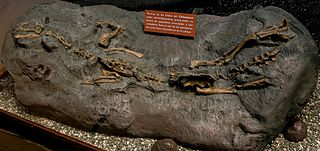
Chilesaurus is an extinct genus of herbivorous dinosaur. The type and only known species so far is Chilesaurus diegosuarezi. Chilesaurus lived about 145 million years ago (Mya) in the Late Jurassic period of Chile. Showing a combination of traits from theropods, ornithischians, and sauropodomorphs, this genus has far-reaching implications for the evolution of dinosaurs, such as whether the traditional saurischian-ornithischian split is superior or inferior to the proposed group Ornithoscelida.

Changmiania is a genus of basal ornithopod dinosaur that lived in what is now China during the Early Cretaceous. It contains a single species, Changmiania liaoningensis.